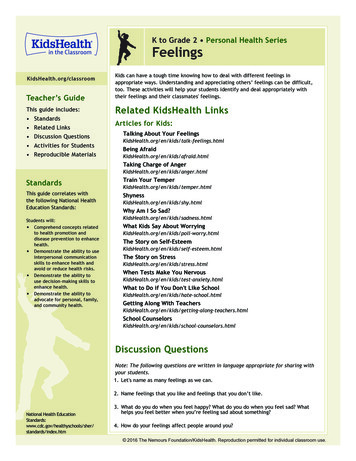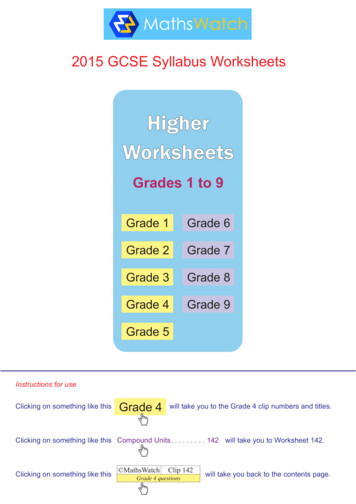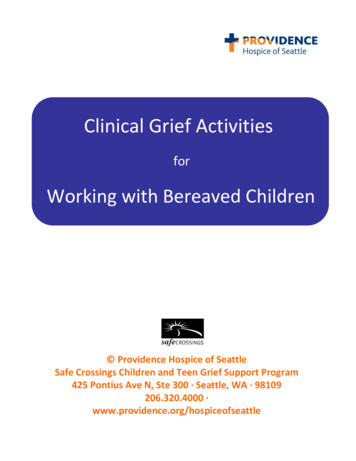
Transcription
K to Grade 2 Personal Health SeriesFeelingsKidsHealth.org/classroomTeacher’s GuideThis guide includes: Standards Related Links Discussion Questions Activities for Students Reproducible MaterialsKids can have a tough time knowing how to deal with different feelings inappropriate ways. Understanding and appreciating others’ feelings can be difficult,too. These activities will help your students identify and deal appropriately withtheir feelings and their classmates' feelings.Related KidsHealth LinksArticles for Kids:Talking About Your eing AfraidKidsHealth.org/en/kids/afraid.htmlTaking Charge of in Your TemperThis guide correlates withthe following National HealthEducation Standards:ShynessStudents will: Comprehend concepts relatedto health promotion anddisease prevention to enhancehealth. Demonstrate the ability to useinterpersonal communicationskills to enhance health andavoid or reduce health risks. Demonstrate the ability touse decision-making skills toenhance health. Demonstrate the ability toadvocate for personal, family,and community h.org/en/kids/shy.htmlWhy Am I So Sad?KidsHealth.org/en/kids/sadness.htmlWhat Kids Say About WorryingKidsHealth.org/en/kids/poll-worry.htmlThe Story on The Story on StressKidsHealth.org/en/kids/stress.htmlWhen Tests Make You t to Do if You Don't Like ng Along With ers.htmlSchool .htmlDiscussion QuestionsNote: The following questions are written in language appropriate for sharing withyour students.1. Let's name as many feelings as we can.2. Name feelings that you like and feelings that you don’t like.National Health /standards/index.htm3. What do you do when you feel happy? What do you do when you feel sad? Whathelps you feel better when you’re feeling sad about something?4. How do your feelings affect people around you? 2016 The Nemours Foundation/KidsHealth. Reproduction permitted for individual classroom use.
K to Grade 2 Personal Health SeriesFeelingsActivities for StudentsNote: The following activities are written in language appropriate for sharing with your students.Good Feelings JournalObjectives:Students will: Identify positive feelings List things that make them feel good Create a class book illustrating things that make them feel goodMaterials: Chart paper and markers or whiteboardPaper to draw and write onPencils, crayons, markersHole punch and paper fasteners or a binding machine"Good Feelings Journal" handoutClass Time:30 minutesActivity:There are many kinds of good feelings: You can feel happy, silly, calm, safe, relaxed, proud, or excited. What othertypes of feelings would you consider to be “good” feelings? What makes you feel good? Sometimes special thingscan make you feel good, like a vacation or birthday party. Little everyday things can make you feel good, too, likeplaying with family member, friend, or pet, or when someone shares toys and games with you.Let’s come up with a list of things that make us feel good. Then, we’ll make a class Good Feelings Journal. Each ofyou will make one page for our journal. You’ll draw a picture of something that makes you feel good, then write asentence at the bottom of the page describing your picture. [Note to instructor: Pre-literate students can dictate asentence for the teacher to write under their pictures. Older students can write their own sentences under theirpictures.]Extension:Students can make their own Good Feelings Journal in which they create multiple pages of different things thatmake them feel good. 2016 The Nemours Foundation/KidsHealth. Reproduction permitted for individual classroom use.
K to Grade 2 Personal Health SeriesFeelingsFeelings and FacesObjectives:Students will: Define these feelings: angry, embarrassed, worried, excited, surprised, sad Identify and discuss how they’d feel if they were involved in a variety of scenarios provided by the teacher Demonstrate the ability to listen to and appreciate classmates’ opinions and feelingsMaterials: "Feelings and Faces" handoutsTape and index cards (one for each child with his/her name on it)Class Time:45 minutesActivity:Look at these six faces. What feeling do you think each of these faces is showing? They are angry, embarrassed,worried, excited, surprised, and sad. Have you ever felt any of these feelings before? When? Today, I’m going toshare some short stories with you and you’re going to think about how you’d feel if you were in each story. After youdecide how you’d feel, you’ll come up to the board and tape your name card under the face that shows how you’dfeel. After reading each situation, ask the following questions: Why would you feel that way in that story? Do youthink it’s OK for other people to feel different than you would? Why?Extensions:1.Kids can make up other scenarios and share them with the class.2.Kids can work in small groups to role-play each of the scenarios.Reproducible MaterialsHandout: Good Feelings rowing/feelings handout1.pdfHandout: Feelings and wing/feelings handout2.pdfKidsHealth.org is devoted to providing the latest children’s health information. The site, which is widelyrecommended by educators, libraries, and school associations, has received the “Teachers’ Choice Awardfor the Family” and the prestigious Pirelli Award for “Best Educational Media for Students.” KidsHealth comesfrom the nonprofit Nemours Foundation. Check out www.KidsHealth.org to see the latest additions! 2016 The Nemours Foundation/KidsHealth. Reproduction permitted for individual classroom use.
Personal Health SeriesFeelingsName:Date:Good Feelings JournalInstructions: Draw a picture of something that makes you feel good, then write a sentence at the bottom of the page describingyour picture or tell your teacher what to write for you. You and your classmates can put all the pages together to create aGood Feelings Journal for the class. 2016 The Nemours Foundation/KidsHealth. Reproduction permitted for individual classroom use.
Personal Health SeriesFeelingsFeelings and FacesNote to instructor: Give each student a card or piece of paper with his or her name on it. Tape the six faces in this handout to awall. Then read each of these situations to your students. After reading each situation, let the students tape their name card underthe face that describes their feelings related to each situation. Ask the kids to explain why they feel that way.Situation 1Situation 2It’s time for recess! You’re planning to playon the swings, but when you get to theplayground, all the swings are being used.It’s the end of the school day. Parents havealready picked up all your classmates, butyour mom or dad isn’t here yet.How do you feel?How do you feel?Situation 3Situation 4You and your friends are playing a board game.All of a sudden your dog runs through the livingroom and over your game. Game pieces goflying and you lose your spot on the board.You’re at an amusement park, next in line toget an autographed picture with yourfavorite character.How do you feel?How do you feel?Situation 5Situation 6You’re at an amusement park waiting in lineto go on a roller coaster that goes really fastand high.Your parents are going to go out to dinner anda babysitter is coming to watch you while yourparents are gone.How do you feel?How do you feel?Situation 7Situation 8You painted a really pretty picture in art classand the teacher holds it up to show everyone.Your best friend invited you to a play dateSaturday. But that morning, your friend’smother calls to say that your friend is sickand the play date is canceled.How do you feel?How do you feel? 2016 The Nemours Foundation/KidsHealth. Reproduction permitted for individual classroom use.
Personal Health SeriesFeelingsFeelings and Faces 2016 The Nemours Foundation/KidsHealth. Reproduction permitted for individual classroom use.
Personal Health SeriesFeelingsFeelings and Faces 2016 The Nemours Foundation/KidsHealth. Reproduction permitted for individual classroom use.
Personal Health SeriesFeelingsFeelings and Faces 2016 The Nemours Foundation/KidsHealth. Reproduction permitted for individual classroom use.
Personal Health SeriesFeelingsFeelings and Faces 2016 The Nemours Foundation/KidsHealth. Reproduction permitted for individual classroom use.
Personal Health SeriesFeelingsFeelings and Faces 2016 The Nemours Foundation/KidsHealth. Reproduction permitted for individual classroom use.
Personal Health SeriesFeelingsFeelings and Faces 2016 The Nemours Foundation/KidsHealth. Reproduction permitted for individual classroom use.
Hole punch and paper fasteners or a binding machine "Good Feelings Journal" handout. Class Time: 30 minutes. Activity: There are many kinds of good feelings: You can feel happy, silly, calm, safe, relaxed, proud, or excited. What other types of feelings would you consider to be "good" feelings? What makes you feel good? Sometimes .










